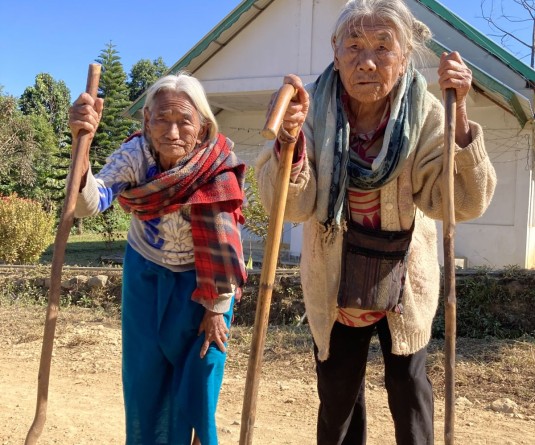
Dr Yansaromo Yanthan
Consultant, MD Radiation Oncology
Eden Medical Centre, Dimapur
Cervical cancer is a major cause of cancer mortality in women and more than a quarter of its global burden is contributed by developing countries. It is a common cancer of the female reproductive system. Owing to effective screening and vaccination its incidence rate is decreasing in the West. Though it is preventable and highly curable, if detected early and treated effectively, in India, cervical cancer is the second most common cancer in females. This is due to lack of proper screening, vaccination, ignorance and low socio-economic status.
In India, according to Global Cancer Observatory (Globocon 2020), an estimated 1,23,907 new cases were detected and 77,348 deaths occurred from cervical cancer. In Nagaland, cervical cancer is the leading cause of cancer with 16.5% followed by breast cancer with 12.2% of the total cancer cases among women. However, the real data will be much higher as many cases remain undiagnosed or unreported.
What are the risk factors?
A risk factor is something that increases the risk of developing a disease.
HPV infection: Among the various risk factors for developing cervical cancer, infection by the human papillomavirus (HPV) attributes to more than 95% of cervical cancer cases and is thus the most important risk factor for cervical cancer. Infection with HPV is common, and in most people the immune system can clear the infection by itself and most pre cancerous lesions resolves spontaneously. Sometimes, however, the infection does not go away and becomes chronic. Chronic infection and pre cancerous lesions, especially when it is caused by certain high-risk HPV types, may eventually progress to invasive cervical cancer.
HPV can spread through sexual activity, including vaginal, anal, and even oral sex. It can also be passed from one person to another by skin-to-skin contact, such as during sexual activity with someone who has the virus.
Other risk factors:
• Becoming sexually active at a young age (especially early age of marriage).
• Multiple childbirths.
• Having multiple sexual partners.
• Having one partner who is considered high risk (someone with HPV infection or who has a history of multiple sexual partners).
• Smoking.
• Presence of Sexually Transmitted Diseases (STDs).
• Prolonged use of oral contraceptive.
• Chronic immune suppression.
What are the symptoms?
Early on, cervical cancer may not be associated with any symptoms. However for invasive carcinoma, most common symptoms are-
• Abnormal vaginal bleeding following intercourse.
• Bleeding after menopause.
• Abnormal vaginal discharges.
• Pain during intercourse.
• Bleeding or spotting between periods or having periods that are longer or heavier than usual.
What can I do to reduce my risk?
The most important thing you can do to reduce the risk of cervical cancer is to have regular screening tests and get vaccinated early.
i) Cervical cancer screening: Cervical cancer has a long pre invasive phase that lasts for more than a decade. This provides a window of opportunity to detect and treat when it is in still in the pre invasive (pre cancerous) stage when treatment can be more successful. Moreover, the sensitivity of cytologic screening makes cervical carcinoma an ideal target for cancer screening. The American Cancer Society recommends that cervical cancer screening should begin at age of 25 and continued till 65 years of age. Screening may be done with either a co-test that combines an HPV test with PAP (Papanicolaou) test/smear every 5 years or another reasonable option is to get tested every 3 years with just PAP test/smear. However, those women over 65 years who have had regular screening in the past 10 years with normal results should stop cervical cancer screening. And for those who have had a total hysterectomy (removal of uterus and cervix) should also stop screening unless the surgery was done as a treatment for cervical cancer or pre invasive cancer.
ii) HPV Vaccination: The HPV vaccine protects against the types of HPV that most often cause cervical, vaginal, vulvar and anal cancers. A recent finding also suggests that HPV vaccine is cutting cervical cancer by nearly 90%. To date, three HPV vaccines are licensed and available: - Cervarix (bi valent), Gardasil (Quadrivalent) and Gardasil 9 (nine valent).
Gardasil 9 (latest vaccine approved in 2015) is a vaccine indicated in girls and women of 9 through 45 years of age. It is also recommended in boys and men for the prevention of anal cancer, genital warts as well as pre cancerous lesion of the anus.
These vaccines only work to prevent HPV infection, they will not treat infection that is already present so it works best if administered prior to exposure to HPV. Therefore to prevent cervical cancer WHO recommends vaccinating girls aged 9 to 14 years when most have not started sexual activity. However, it may be noted that HPV vaccination does not eliminate the necessity to undergo regular screening. People who have been vaccinated against HPV should still follow guidelines for regular screening test appropriate for their age groups.
Early detection greatly improves the chances of successful treatment of pre-cancer and cancer of the cervix. It is best advised to take precaution at the earliest by screening (undergoing a pap smear test), getting the HPV vaccine and moreover observing oneself of any of the above symptoms.




